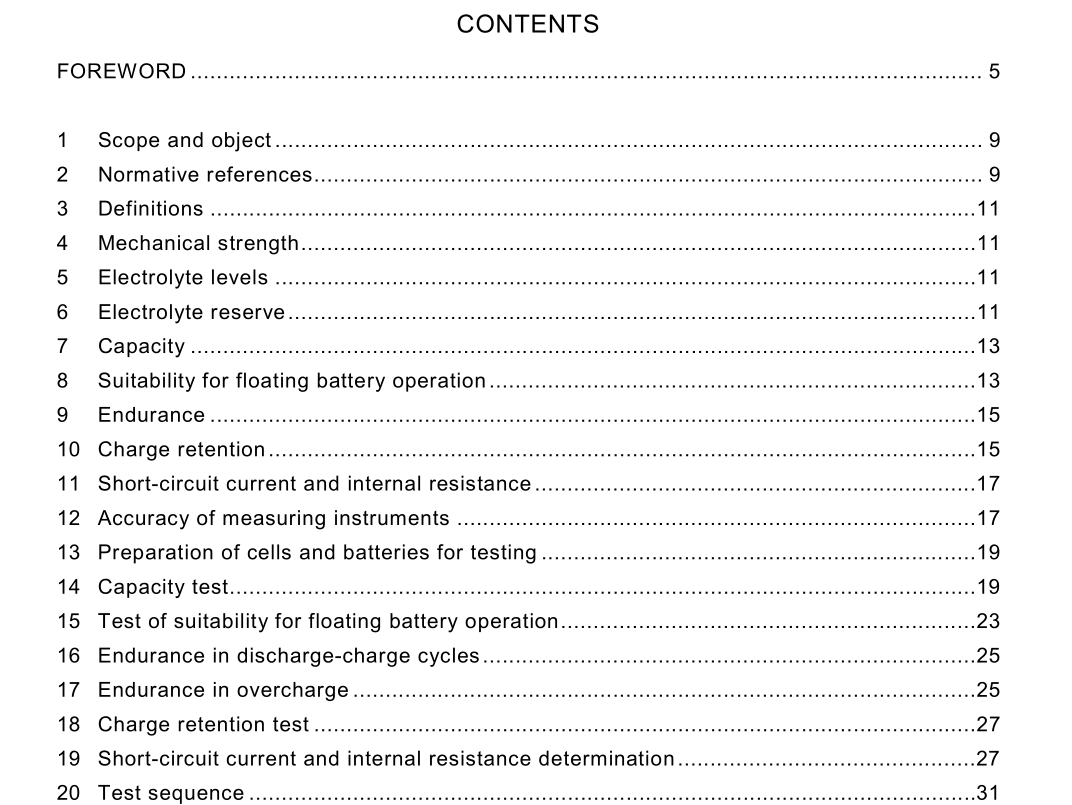IEC 60896-11 pdf download

IEC 60896-11 pdf download.Stationary lead-acid batteries
1 Scope and object
This part of IEC 60896 is applicable to lead-acid cells and batteries which are designed for service in fixed locations (i.e. not habitually to be moved from place to place) and which are permanently connected to the load and to the d.c. power supply. Batteries operating in such applications are called“stationary batteries’ ‘ . Any type or construction of lead-acid battery may be used for stationary battery applications. This part 11 of the standard is applicable to vented types only. The object of this standard is to specify general requirements and the main characteristics, together with corresponding test methods associated with all types and construction modes of lead-acid stationary batteries, excluding valve-regulated types. Recommendations on the use of tests for stationary battery application are given in Table A.1. Recommendations relating the type of cell or monobloc to the use of tests are given in Table A.2. Statements and claims of basic performance data by the manufacturer shall corres pond to those tests. The tests may also be used for type qualification
3 Definitions
For the purposes of the present part of IEC 60896, the following definitions apply. 3.1 electrolyte reserve volume of electrolyte between minimum and maximum level indication 3.2 rated capacity Crt quantity of electricity, declared by the manufacturer, which a cell or battery can deliver under specified conditions after a full charge. This value is usually expressed in ampere-hours (see IEV 486-03-22) 3.3 nominal capacity C nom suitable approximate quantity of electricity used to identify the capacity of a cell or battery. This value is usually expressed in ampere-hours (see IEV 486-03-21) 3.4 endurance ability of a cell or battery to function and withstand operations under specified conditions for a minimum period of time or repeated application thereof
8 Suitability for floating battery operation
(Test, see Clause 15). 8.1 Stationary batteries are mainly used in floating operation A battery in floating operation has a constant voltage UIo, permanently applied to its terminal which is sufficient to maintain it in a state close to full charge and is intended to supply a circuit whose normal power supply may fail. Suitability for this operation shall be checked by a test carried out on cells or on batteries. Batteries which are not in true floating operation (for example, solar power storage) should not be qualified according to the test method described in Clause 15. 8.2 Batteries operating in continuous floating operation Batteries operating in continuous floating operation according to Clause 15 shall meet the following requirements: a) the electrolyte densities shall remain within specified limits in all cells; b) the individual cell voltages shall remain within specified limits; NOTE In some batteries with monobloc design the voltage of individual cells cannot be measured. In those cases the assessment of uniformity should be made with the voltage of individual monobloc units. c) after a period of six months the actual capacity Cg on discharge according to Clause 14 shall be at least equal to Crt; d) after a period of six months the loss of electrolyte shall not exceed 50 % of the volume between the minimum and maximum levels. The volume between the minimum and maximum levels shall be available from the manufacturer.
9 Endurance
See definition 3.4. Depending on the battery and system application an endurance test based on discharge- charge cycles or an overcharge shall be carried out. 9.1 Endurance in cycles The endurance in discharge-charge cycles shall be tested according to Clause 16 where frequent discharges of the battery are to be encountered due either to a deliberate choice of operational application or to frequent power-line outages. The minimum requirement of the test shall be two sets of 50 cycles each (N = 100 cycles) before capacity drops below 0,95 C10 where C10 is the rated capacity at the 10 h-rate Optionally, the manufacturer may state the number of cycles as Ca= 0,8 . C10. 9.2 Endurance in overcharge The endurance in overcharge shall be tested according to Clause 17 where natural overcharge related potential failure modes such as corrosion of grids, plate group bars or terminals of the battery are to be encountered due either to high ambient temperatures, poor float voltage regulation or similar. The minimum requirement of the test shall be six periods of 720 h each before the capacity drops below 0,8 C where C is the rated capacity at the 1 h rate to Uq as defined in Clause 7.









